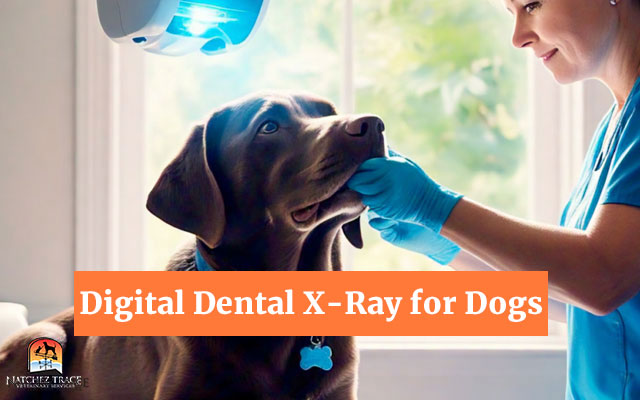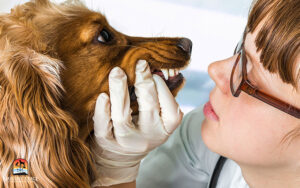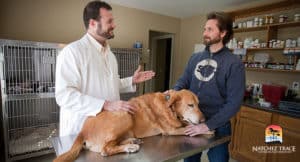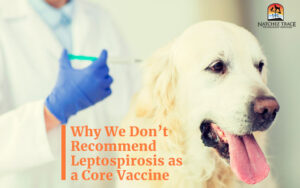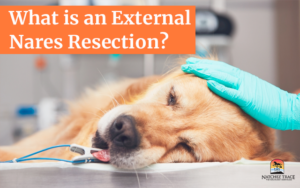Digital dental X-ray for dogs is a game changer for pet health.
These advanced X-rays go beyond the surface, revealing hidden dental problems that could affect your dog’s overall health. From identifying infections to planning treatments, digital dental X-rays help vets provide the best care possible, ensuring your dog stays happy and healthy for years.
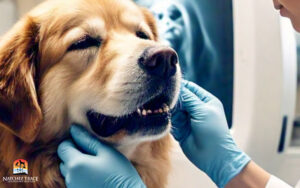 What Is a Digital Dental X-Ray for Dogs?
What Is a Digital Dental X-Ray for Dogs?
It’s more than just pictures of your dog’s teeth. Digital X-rays are essential for uncovering hidden dental issues that may not be immediately visible during a physical exam.
They can reveal problems such as tooth root infections, which, if left untreated, may lead to chronic pain, inflammation, or even systemic health complications. Hidden fractures beneath the gum line are another concern often missed during routine exams; these fractures can cause significant discomfort and require prompt attention.
Additionally, digital X-rays can detect impacted teeth trapped beneath the gum line, which may lead to discomfort, crowding, or misalignment, potentially affecting overall dental health. By identifying these hidden issues early, digital X-rays allow for accurate diagnosis and timely treatment, promoting better oral health and preventing more serious complications in the future.
How It Works
Digital dental X-rays utilize advanced sensors to capture high-resolution images of your dog’s teeth, roots, and jawbone with remarkable speed and accuracy. These images provide a detailed view that allows us to identify issues that may not be apparent during a routine physical exam. For example, infections at the root level, minor fractures beneath the gum line, or early signs of bone loss can be detected before progressing into more serious conditions. The process is efficient and minimizes discomfort for your pet, as it requires less time than traditional X-rays.
Digital X-rays are also safer for pets and veterinary staff, as they use significantly lower radiation levels than traditional methods. The high-quality images can be easily enhanced, shared, or stored for future reference, enabling more precise treatment planning and long-term dental health monitoring. By leveraging this technology, we can diagnose and address dental problems early, ultimately improving your dog’s quality of life and preventing unnecessary pain or complications.
Why It’s Better Than Traditional X-Rays
Digital X-rays offer significant advantages over traditional X-ray methods, making them faster, safer, and more effective for your dog’s dental care. One key benefit is reduced radiation exposure, which ensures a safer experience for your pet and our veterinary staff. Despite the lower radiation levels, digital X-rays produce sharper, more detailed images that allow for a more precise evaluation of your dog’s teeth, roots, and jawbone.
This enhanced accuracy helps us detect hidden dental issues with greater confidence, such as minor fractures, root infections, or bone loss. The speed of digital imaging also means less time spent positioning your dog, reducing stress and discomfort during the procedure. Additionally, digital X-rays provide instant results, allowing us to analyze the images immediately and discuss treatment options without delay.
Another advantage is that digital images can be easily stored, enhanced, and shared. The high-resolution images can be used to monitor your dog’s long-term dental health or sent to specialists for further consultation. Digital X-rays ensure your dog receives the best possible care and preventative treatment by combining safety, efficiency, and superior diagnostic capabilities.
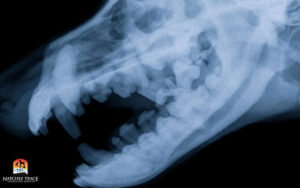 Why Pets Need Dental X-Rays
Why Pets Need Dental X-Rays
Some dental problems aren’t visible to the naked eye.
Digital dental X-rays help uncover hidden issues, giving your dog the best chance for a healthy, pain-free life.
Spotting Hidden Problems
Digital X-rays reveal what a physical exam can’t, such as:
- Tooth root infections that may cause chronic pain.
- Fractures beneath the gum line that need immediate attention.
- Impacted teeth that can lead to discomfort or misalignment.
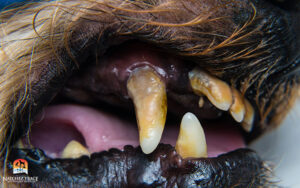 Early Detection of Dental Disease
Early Detection of Dental Disease
Digital X-rays prevent minor problems from escalating into severe conditions by catching issues early. This proactive approach ensures your dog stays comfortable and avoids unnecessary complications like advanced periodontal disease or tooth loss.
Benefits of Digital Dental X-Rays for Dogs
Keeping your dog healthy starts with their teeth.
Digital dental X-rays are a key preventive care tool, helping catch and treat issues early.
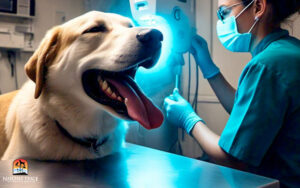 Non-Invasive and Quick
Non-Invasive and Quick
Digital X-rays are completely safe and painless for your dog. The process takes just a few minutes, minimizing stress while providing essential insights into their oral health.
Improved Treatment Plans
With detailed, high-quality images, we can:
- Accurately diagnose dental issues.
- Tailor treatments to address specific problems.
- Ensure your dog receives the most effective care, whether cleaning, extractions, or other procedures.
When Does Your Dog Need a Dental X-Ray?
Are you wondering if your dog might need a dental X-ray?
There are specific situations and symptoms where a digital dental X-ray is critical for safeguarding your dog’s oral and overall health.
Signs Your Dog May Need a Dental X-Ray
While routine dental checkups help maintain your dog’s oral health, sure signs and symptoms signal the need for a closer look:
- Bad Breath (Halitosis): Persistent bad breath could indicate underlying issues, such as periodontal disease or infections, that may not be visible during a physical exam.
- Loose or Missing Teeth: These can be signs of advanced gum disease, bone loss, or trauma that require a detailed evaluation to assess the extent of the damage.
- Swelling or Redness: Inflammation around the gums or jaw might indicate an abscess, infection, or other dental conditions requiring immediate attention.
- Difficulty Eating or Chewing: If your dog shows discomfort while eating or avoids chewing on one side of their mouth, a dental X-ray can help identify the cause, such as a cracked tooth or oral pain.
- Facial Swelling or Discharge: These symptoms may be related to dental infections or tumors that must be accurately diagnosed with imaging.
If you notice any of these signs, an X-ray can uncover hidden issues like fractures, infections, or abscesses that need immediate attention.
Situations Where Dental X-Rays Are Necessary
In addition to symptoms, there are specific scenarios where digital X-rays play a crucial role:
- Before Tooth Extractions: To evaluate the root structure and surrounding bone to ensure a safe and complete removal.
- After Trauma: X-rays can help detect hidden fractures or internal damage after an injury to the mouth or face.
- Monitoring Dental Health: Regular X-rays are often recommended for dogs with a history of dental disease to track changes and prevent future issues.
- Puppy Development: X-rays monitor the growth and alignment of teeth in breeds prone to dental problems.
Proactive Dental Care
Digital dental X-rays provide a detailed look beneath the surface, uncovering issues that a physical exam alone cannot detect. Addressing dental problems early can prevent discomfort, improve your dog’s quality of life, and avoid costly treatments later.
If you notice any of these symptoms or we recommend a dental X-ray, rest assured that the procedure is safe, quick, and highly effective at protecting your dog’s health.
Digital X-Rays and Safety
Are digital X-rays safe for your dog?
Thanks to modern advancements, digital dental X-rays are safe, highly efficient, and designed to minimize stress for your furry companion. They are essential in veterinary care and ensure your pet’s comfort and well-being.
Low Radiation Levels
One key safety feature of digital X-rays is their use of advanced technology to reduce radiation exposure dramatically compared to traditional X-rays. The radiation levels are so minimal that they pose no significant risk to your dog, making the procedure safer for both pets and veterinary staff. Despite this reduced exposure, digital X-rays provide detailed, high-quality images that enable accurate diagnosis and effective treatment planning.
Designed for Comfort
Digital X-rays are designed with your dog’s comfort in mind. The procedure is quick, non-invasive, and tailored to minimize discomfort. Specialized sensors, smaller and more ergonomic than traditional X-ray plates, fit comfortably in your dog’s mouth and capture images in just a few minutes. This streamlined process reduces your pet’s time to remain still, making the experience less intimidating.
We are trained to use gentle handling techniques for particularly anxious or uncooperative dogs to keep your pet calm. In some cases, mild sedation may be offered to ensure a stress-free experience, especially if the dog has a history of dental issues or fears veterinary procedures.
Prioritizing Your Dog’s Well-Being
Digital X-rays are vital diagnostic tools that combine safety, comfort, and efficiency. By identifying issues such as hidden fractures, root infections, or bone loss early, we can provide timely treatment and prevent complications. The process is safe, painless, and critical to maintaining your dog’s health and happiness.
With digital X-rays, you can feel confident that your dog receives the best possible care safely and comfortably.
Can Pregnant Dogs Have Dental X-Rays?
The safety of expectant moms and their puppies is always a top priority.
Dental X-rays may sometimes be necessary for pregnant dogs to diagnose and treat oral health issues affecting their well-being. When X-rays are required, we take every precaution to ensure the procedure is as safe as possible for the mother and her developing puppies.
Safety Measures
Modern digital X-ray technology significantly reduces radiation exposure compared to traditional methods, making it a safer option for pregnant dogs. Additionally, protective lead shielding covers the abdomen, minimizing any potential radiation exposure to the puppies. The targeted nature of dental X-rays further ensures that radiation is focused on the specific area being examined, leaving the rest of the body unaffected.
Weighing the Risks and Benefits
While we strive to avoid unnecessary procedures during pregnancy, untreated dental issues—such as severe infections or abscesses—can lead to systemic health problems that may pose a greater risk to the mother and her litter than the X-ray itself. By carefully assessing the situation, we can determine whether the benefits of a dental X-ray outweigh the risks.
A Tailored Approach
Every pregnant dog is unique, and we approach each case individually. We consider the stage of pregnancy, the severity of the dental issue, and any alternative diagnostic options before proceeding. When X-rays are deemed necessary, we perform the procedure quickly and with minimal stress to ensure the mother’s comfort.
With advanced technology and strict safety protocols, digital dental X-rays can be a safe and effective diagnostic tool for pregnant dogs when needed. Trust that we will best safeguard the expectant mom’s and her puppies’ health.
Healthy Teeth Mean a Healthier Dog
Digital dental X-rays are vital for keeping your dog happy and healthy. They can identify and prevent dental problems before they escalate.
Regular dental care, including digital X-rays, ensures your dog’s mouth stays in top condition. By detecting hidden issues like infections, fractures, or bone loss, we can address problems early, sparing your dog unnecessary pain and improving their quality of life.
Digital dental X-rays aren’t just for emergencies—they’re a proactive step in maintaining your dog’s overall health. Combined with routine dental cleanings and checkups, they form a comprehensive care plan to keep your furry friend feeling their best.
Work closely with our veterinarian to develop a dental care routine that includes X-rays as needed. Preventive care ensures your dog enjoys a lifetime of wagging tails, playful energy, and bright smiles.
FAQs:
- Why are dental X-rays important for my dog?
Dental X-rays detect hidden issues like infections, fractures, and tumors, ensuring better oral health. - How often should my dog have a dental X-ray?
Most dogs benefit from an X-ray during routine dental cleanings, typically once a year. - Is anesthesia required for a dog dental X-ray?
Yes, anesthesia ensures your dog stays still, allowing for clear images and a stress-free experience.

